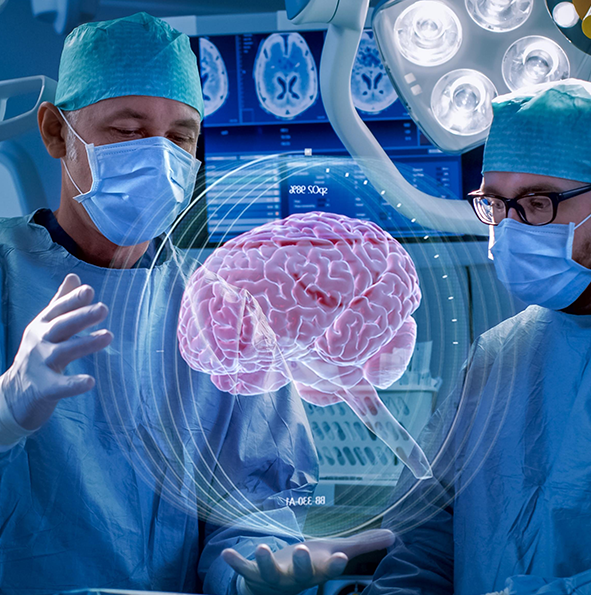Brain Tumor: Introduction
When there's unusual cell growth near or inside the brain, it's referred to as a brain tumor. These growths can originate from the brain itself, known as primary brain tumors. At times, tumors may develop in proximity to the brain in areas such as neural pathways, the pituitary gland, the pineal gland, and the brain's coverings.
Another type of brain tumor is called metastatic or secondary tumor, which occurs when cancer from other parts of the body spreads to the brain.
Brain tumors vary in size, ranging from small to large. Some are detected early because they cause immediate symptoms, while others can significantly impact health before becoming apparent. The manifestation of symptoms depends on the tumor's location. If it's in a less active part of the brain, symptoms may not appear right away, and the tumor could grow considerably before being detected.
The appropriate treatment depends on the tumor type, its location, and size. Common treatments include radiation therapy and surgery.
Types of Brain Tumors
While there are many different types of brain tumors, what determines its type is the kind of cells that make up the tumor.
Some common types of brain tumors include:
-
Gliomas and Related Brain Tumors: Brain tumors associated with gliomas. Cell growths that resemble glial cells are known as gliomas.
-
Choroid Plexus Tumors: Tumors of the choroid plexus originate from cells that produce the fluid that covers the brain and spinal cord.
-
Embryonal Tumors: Cells that are left behind during fetal development cause fatal embryonal tumors. The embryonal cells stay in the brain after birth.
-
Germ Cell Tumors: The germ cells that develop into the sperm and egg cells are the initial stages of germ cell cancers. Germ cells are mainly in the testicles and ovaries.
Brain Tumor: Causes And Symptoms
Causes
DNA alterations in or around the brain result in brain tumors. The instructions that inform a cell what to do are encoded in its DNA. The alterations instruct the cells to grow rapidly and survive when healthy cells would normally disappear as a part of their normal life cycle. This produces a large number of additional brain cells. The cells may develop into a development known as a tumor.
The specific reason for the DNA changes that result in brain tumors is unknown. The cause of brain tumors in many cases remains unknown.
Symptoms
The symptoms and indications of a brain tumor depend on the size and location of the tumor.
The following are some common indications and symptoms of brain tumors:
-
head pressure or headache that is worse first thing in the morning
-
headaches that appear worse and occur more frequently
-
Vomiting or nausea
-
Eye issues - double vision, fuzzy vision, and vision loss on the sides of your field of vision
-
Losing the ability to move or feel in an arm or leg
-
Having trouble with balance
-
Difficulty in hearing
-
Feeling exhausted very often
-
Confusion in basic everyday tasks
-
Memory issues
-
Trouble following basic commands
-
Sudden behavior or personality changes
-
Getting seizures, especially if there is no history of seizures
Diagnosis And Treatment
Diagnosis
If your physician suspects you may have a brain tumor, you might need to take several tests and procedures to confirm the diagnosis. These might include:
-
A Neurological Examination: A neurological examination examines the function of several brain regions. Your vision, hearing, balance, coordination, strength, and reflexes may all be examined during this examination.
-
Brain CT scan: X-rays are used in computed tomography scans, or CT scans, to create images. It's widely accessible and gives fast results.
-
Brain MRI: Strong magnets are used in magnetic resonance imaging, or MRI, to provide images of the inside of the body. Since MRI provides a clearer image of the brain than other imaging procedures, it is frequently used to identify brain cancers.
-
Brain PET Scan: PET (also known as positron emission tomography imaging) scan can detect certain brain tumors. A radioactive tracer is injected into a vein during a PET scan. The tracer reaches brain tumor cells via the blood and adheres to them. In the images captured by the PET scanner, the tracer highlights the tumor cells.
Treatment
The course of treatment for a brain tumor depends on whether the tumor is fatal or benign (also known as not cancerous). The treatment option will depend on several factors including the type, size, grade, and location of the brain tumor. Radiation therapy, radiosurgery, chemotherapy, targeted therapy, and surgery are some options. Your healthcare provider takes your preferences and general health into account when deciding on a course of therapy.
Why Choose WIINS
Looking for top-notch neurological care in Kolhapur? Look no further! WIINS is nestled in a beautiful 3.5-acre landscape and stands tall as one of India's largest Neuroscience hospitals and a premier reference center. With over 55 years of expertise, WIINS excels in providing cutting-edge healthcare that's both advanced and affordable.
We are dedicated to:
-
Delivering High-Tech Neurological Healthcare
-
Providing a Welcoming and Compassionate Environment
-
Innovative Treatments & World-Class Facilities
-
Providing Exceptional Neurological Care
-
Providing Rehabilitation through Advanced Technology
WIINS is also one of the few hospitals in India offering postgraduate training in neurosurgery. The Direct 6-year Post-MBBS Dr NB Neurosurgery Program has been approved by the National Board of Examination, taking into account the qualitative and quantitative enhancement of WIINS. Only a few neurosurgery hospitals in India have been awarded this prestigious honor.
